Physical Address
304 North Cardinal St.
Dorchester Center, MA 02124
The pleura is composed of two thin layers of mesothelium referred to as the visceral and parietal pleura. The visceral pleura covers the lung and fissural surfaces and the parietal pleura lines the mediastinum, ribs, and diaphragm. The visceral and parietal pleura differ in their arterial supply and their venous and lymphatic drainage. The visceral pleura is supplied by the pulmonary arterioles and capillaries and drains via the pulmonary veins, and the parietal pleura is supplied by systemic arterioles and capillaries, which drain into the systemic venous system via the azygous, hemiazygous, and internal mammary veins into the right atrium. The visceral and parietal pleura surround the hilum. Just below the hila, two layers of parietal pleura come together and extend inferiorly to the diaphragm to form a free edge known as the inferior pulmonary ligament, tethering the lower lung to the mediastinum.
The pleural space is a potential space and normally contains up to 10 mL of pleural fluid. Physiologic pleural fluid is constantly produced by the parietal pleura and absorbed by the lymphatics. Visceral pleural lymphatics drain centrally via the interlobular septae into the hila, and parietal pleural lymphatics drain into the thoracic duct.
Abnormal accumulation of pleural fluid occurs when the rate of pleural fluid production outpaces the rate of absorption. There are two main types of pleural effusions: transudates and exudates. Transudates are usually caused by increased local capillary hydrostatic pressure and decreased oncotic pressure, as in the setting of hypoalbuminemia, congestive heart failure, hepatic cirrhosis, and renal failure with volume overload. In contrast, exudates result from infectious, inflammatory, and neoplastic processes with secondarily increased permeability of the microvascular circulation. Common causes of exudates include pneumonia, pleural tumors, and inflammatory conditions such as lupus and rheumatoid arthritis.
A freely layering pleural effusion is more commonly transudative than exudative. On an upright chest radiograph (CXR), it manifests as blunting of the costophrenic angles, with an associated concave-upward interface known as the “meniscus sign” ( Fig. 7.1 ). CXR projections differ in their sensitivity for detection of pleural effusions. The upright lateral projection is more sensitive than an upright frontal radiograph in the detection of very small pleural effusions, demonstrating as little as 50 to 75 mL of pleural fluid in the posterior costophrenic angles, the most dependent part of the thorax. Typically, closer to 200 mL of fluid is necessary to blunt the lateral costophrenic angles on a frontal CXR. On a supine CXR, a pleural effusion layers posteriorly, giving rise to hazy opacity overlying the lung, through which the pulmonary vessels can often still be visualized, with the extent of opacification depending on the size of the pleural effusion ( Fig. 7.2 ). Pleural fluid may also track into the fissures ( Fig. 7.3 ) and around the lung apex, producing an “apical cap.”
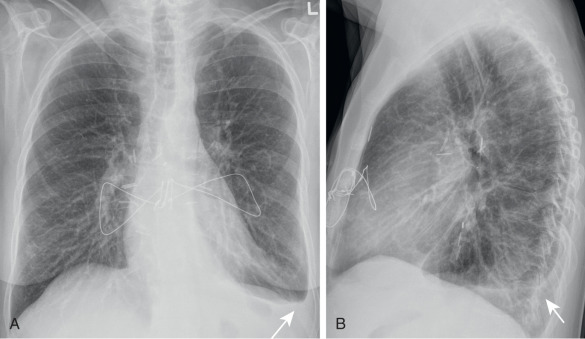
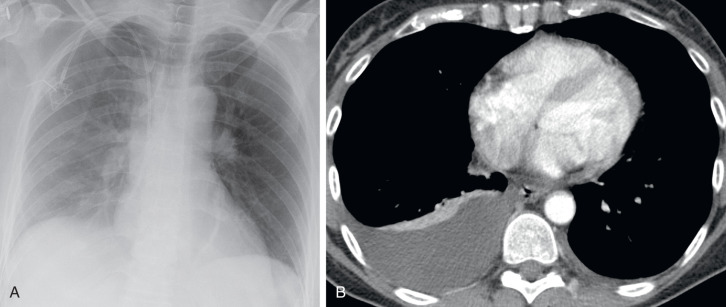
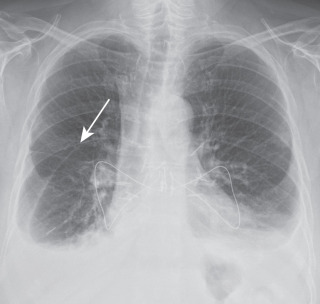
When massive, pleural effusions may yield complete or near complete opacification of the ipsilateral hemithorax, with contralateral displacement of the mediastinum ( Fig. 7.4 ). This contralateral shift can help distinguish complete hemithoracic opacification caused by a large pleural effusion from atelectasis alone; in the latter case, the mediastinum would be expected to shift ipsilaterally. Often, both pleural fluid and atelectasis are present, however, and their relative preponderance will dictate the degree of cardiomediastinal shift.
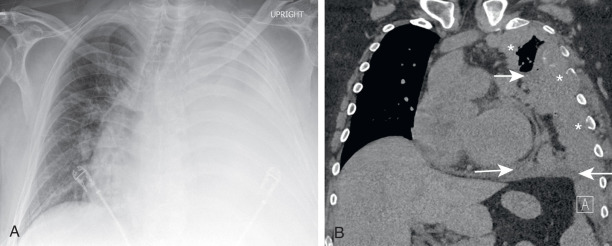
On chest computed tomography (CT), free-flowing pleural fluid produces a sickle-shaped water-attenuation opacity in the dependent aspect of the thorax. Compared with CXR, cross-sectional imaging by CT and magnetic resonance imaging (MRI) are more sensitive and specific in the detection of very small amounts of pleural fluid. Ultrasonography can also be used to image pleural fluid, provided there is an ample acoustic window.
Occasionally, free-flowing pleural fluid may accumulate in a subpulmonic position—that is, between the inferior surface of the lung and the hemidiaphragmatic pleura. In this situation, the lateral costophrenic angle may remain sharp until a large amount of fluid has accumulated and eventually spills into it. On a frontal CXR, a subpulmonic pleural effusion mimics elevation of the ipsilateral hemidiaphragm, yielding a “pseudo-diaphragm” appearance. However, closer scrutiny will reveal flattening of the medial aspect of the apparent hemidiaphragm with displacement of the peak of the apparent hemidiaphragm laterally ( Fig. 7.5 ). On the left, increased distance between the apparent surface of the left hemidiaphragm and the underlying gastric bubble may also indicate the presence of a subpulmonic pleural effusion.
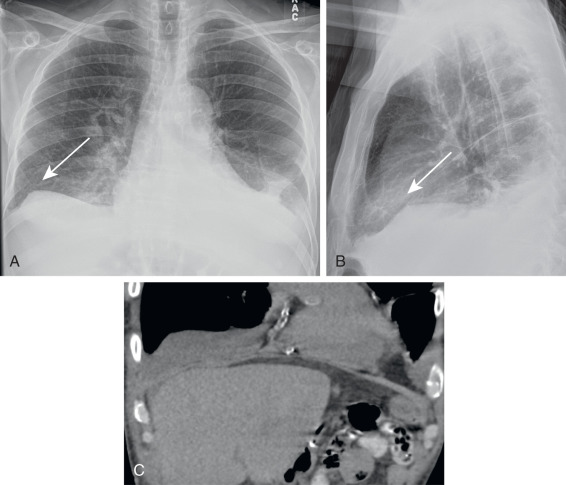
Pleural fluid can become loculated when it no longer shifts freely in the pleural space, often because of adhesions between the visceral and parietal pleura. A loculated pleural effusion is usually exudative. If pleural adhesions are present and preexist the new pleural effusion, they may result in loculation of serous or transudative pleural fluid, which would otherwise layer. On CXR, CT, and MRI, a loculated pleural effusion does not behave according to the laws of gravity and manifests with fairly fixed morphology, despite change in patient position. It often exhibits an undulating, lobulated, or other gravity-defying contour, whether located dependently or nondependently within the thorax ( Fig. 7.6 ). Occasionally, pleural fluid may accumulate within a fissure in such a manner that it mimics a mass or pseudotumor ( Fig. 7.7 ). If necessary, right-side-down or left-side-down lateral decubitus views can be obtained to problem solve because free pleural fluid will shift and layer dependently on decubitus views, but loculated fluid will not. In general, however, when pleural fluid defies gravity, it is loculated, and no additional views are needed to make this determination. Ultrasonography at the bedside can be used to distinguish free-flowing from loculated pleural effusions and, similar to MRI, can better detect internal septations within an exudative pleural effusion than CXR and CT.
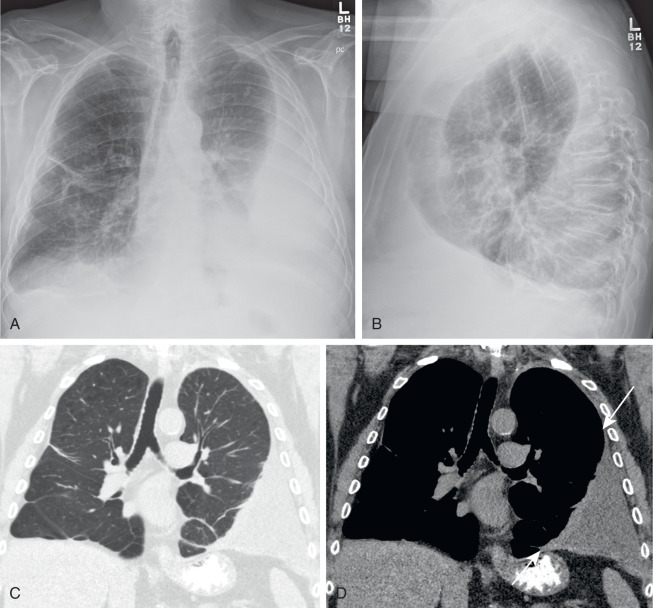
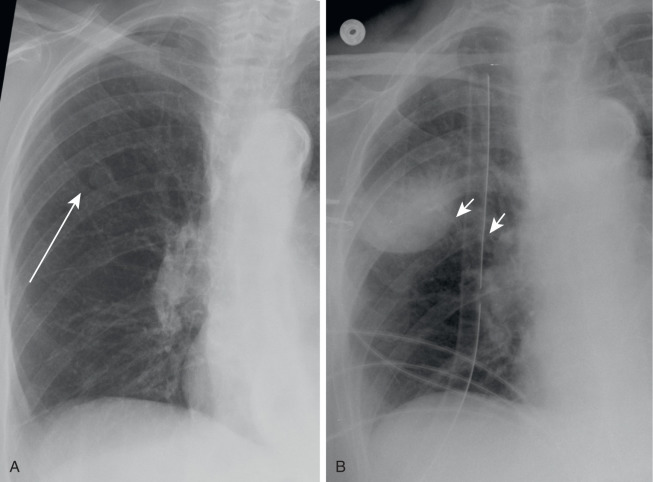
A hydropneumothorax is defined as the presence of air and fluid of any type in the pleural space. It often produces an air–fluid level in the pleural space on an upright CXR ( Fig. 7.8 ). When an air–fluid level is present in the pleural space, its length classically varies on posteroanterior and lateral radiographs. Classically, a shorter air–fluid level may be seen on one view than the other. This feature helps to distinguish a hydropneumothorax or empyema from a lung abscess, in which the length of the air–fluid level is more apt to be equal on both views. Please see below for a further discussion of pneumothorax.
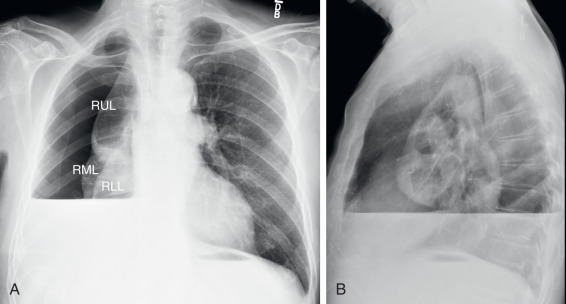
An exudative pleural effusion with frank pus is referred to as an empyema. Most empyemas are caused by complications of bacterial pneumonia, an adjacent lung abscess, or both. They may also arise from chest trauma with introduced infection or superinfection, direct extension of a subphrenic abscess or vertebral osteomyelitis with phlegmon into the pleural space, and hematogenous spread of infection. The natural progression of an empyema consists of several phases: an exudative pleural effusion acutely, then a fibrinopurulent phase, and later an organizing phase, when thickened pleura (termed a fibrin peel ) develops. Early diagnosis and treatment of an empyema are of paramount importance to prevent potential complications, including bronchopleural fistula formation, recurrent empyema, and pleural thickening and fibrosis with trapped lung, the latter of which may require surgical decortication. When an empyema drains through an infection- or inflammation-created opening or sinus tract in the chest wall, it is referred to as empyema necessitans. Tuberculosis (TB), actinomycosis, and several fungal diseases are the most common precipitants of this finding (see Chapter 16 ).
On CXR, an empyema often manifests as a loculated pleural effusion. If an abnormal communication between the pleural space and the lung (bronchopleural fistula) develops, air accumulates in the pleural space, forming a hydropneumothorax.
The classic chest CT finding for empyema is the “split pleura sign,” which manifests as enhancing, separated, and thickened leaves of visceral and parietal pleura encompassing a tense, bulging, lenticular collection of pleural fluid. When present, this finding is virtually diagnostic of an empyema ( Fig. 7.9 ). MRI manifests similar findings; however, it is important to be aware that pleural enhancement is more readily apparent by MRI than CT because of MRI's higher soft tissue contrast and can be seen in other inflammatory and neoplastic processes besides empyema. As always, morphology and clinical context must be considered. Cross-sectional imaging is particularly helpful in distinguishing an empyema from a lung abscess ( Table 7.1 ). Both CT and ultrasonography can be used to guide percutaneous diagnostic and therapeutic drainage of empyemas, particularly when composed of multiple loculations and septations.
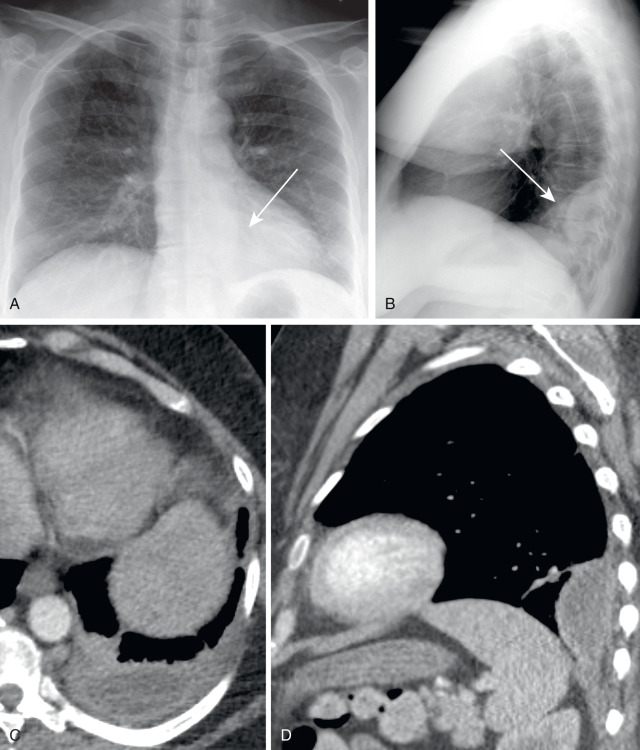
| Computed Tomography Features | Empyema | Lung Abscess |
|---|---|---|
| Shape | Lenticular | Round |
| Angle with pleura | Obtuse | Acute |
| Boundary with lung | Distinct; compresses adjacent lung | Less distinct boundary with the adjacent lung |
| Bronchovascular structures | Compressed and draped around an empyema | Terminate abruptly at the margins of a lung abscess |
| Split pleura sign | Present | Absent |
A hemothorax represents blood within the pleural space. Hemothoraces are most commonly caused by chest trauma, although hemorrhagic effusions may also occur in the setting of neoplasm, pulmonary infarction, infections such as TB, and coagulopathies. Chronic hemothoraces may result in chronic pleural thickening with tethering; multifocal parenchymal bands; and volume loss of the adjacent lung, otherwise known as a fibrothorax. If functionally limiting, this occurrence may warrant thoracotomy and decortication.
On CXR, a hemothorax may not be distinguishable from a free-flowing or loculated pleural effusion, although clinical history or findings compatible with acute chest trauma, such as pneumothorax and acute rib fractures, may suggest this entity. Recent pleural hemorrhage may be identified by the presence of hyperattenuating fluid on CT and T1 hyperintensity on MRI, as opposed to serous pleural fluid, which is of homogeneous water attenuation on CT and T1-hypointense and T2-hyperintense on MRI. A fluid-fluid level, sometimes referred to as a “hematocrit level,” may be present because of dependent layering of the denser cellular elements and less dependent layering of the more serous elements of the blood ( Fig. 7.10 ).
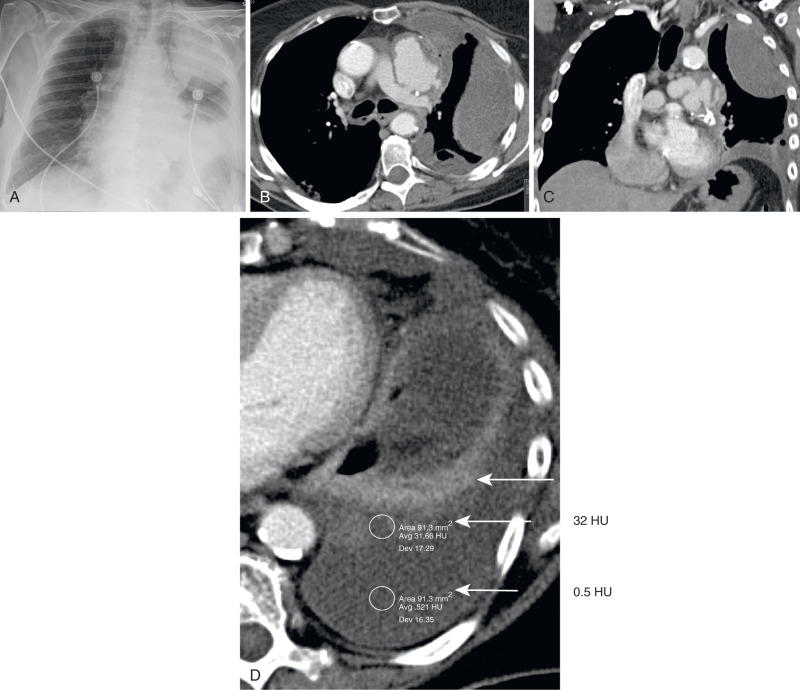
Disruption of the major lymphatic channels, such as the thoracic duct, results in a chylothorax, with increased levels of triglycerides and cholesterol in the pleural fluid. Common causes of chylothorax include neoplasms (e.g., lymphoma), trauma (both surgical and nonsurgical), and infection (e.g., TB). Lymphangiomatosis is a rare cause ( Fig. 7.11 ). A chylothorax is not readily distinguishable from a transudative pleural effusion on both CXR and CT. Despite the fat content, the CT attenuation is usually close to that of water. CT may be helpful in identifying the cause of chylothorax, such as lymphoma and chest trauma. MRI may be helpful in noninvasive confirmatory diagnosis of a chylothorax when the pleural fluid is T1-hyperintense (and hemorrhage is not a consideration) or when the fluid suppresses on opposed-phase chemical shift MRI secondary to the presence of microscopic fat and water in the same voxel.
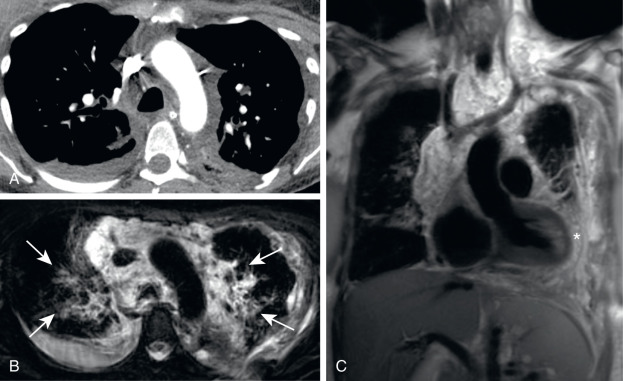
Pneumothorax is defined as the abnormal presence of air or gas within the pleural space, or technically, the interpleural space. Air may enter the pleural space by several routes: via the lung, airways, esophagus, mediastinum (rarely, in the setting of pneumomediastinum), or the chest wall (in the setting of penetrating chest trauma).
Pneumothoraces may be spontaneous or secondary. Spontaneous pneumothoraces most commonly occur in otherwise healthy, tall, slender young men. They are caused by the rupture of small bullae or air pockets within the elastic fibers of the visceral pleura, most typically in the lung apices. Secondary causes of pneumothorax include a wide range of disease entities, such as chronic obstructive pulmonary disease, especially associated with apical bullae, cystic lung disease (e.g., cystic fibrosis, Pneumocystis jiroveci pneumonia, Langerhans cell histiocytosis, lymphangiomyomatosis), metastatic sarcoma (prototypically osteosarcoma), and rarely, pulmonary infarcts. Chest trauma, both open and closed or blunt, is a common cause of pneumothorax (see Chapter 13 ). Recent thoracic surgery, central line placement, thoracentesis, percutaneous biopsy of the lung and upper abdominal organs, and mechanical ventilation can result in iatrogenic pneumothorax (see Chapters 10 and 13 ). Catamenial pneumothorax is a rare manifestation of intrathoracic endometriosis and occurs in cyclic fashion, coincident with menses.
On CXR, a pneumothorax most commonly manifests as interpleural air—that is, air-filled lucency, devoid of vessels, located between the fine, smooth, thin visceral pleural line and the parietal pleura, generally along the chest wall but sometimes along the diaphragmatic parietal pleura, mediastinal pleura, or within a pulmonary fissure. A basic concept in imaging interpretation is that air rises. Therefore, on an upright CXR, a pneumothorax is most frequently, but not always , apical in location ( Fig. 7.12 ). When the patient is supine, interpleural air typically collects anteriorly. Therefore, a pneumothorax may be more difficult to detect in a supine patient and may be anteromedial or basilar in location, for example. Anteromedial air in the pleural space may produce an abnormally sharp cardiomediastinal border. Air may also collect within the costophrenic sulcus, yielding a “deep sulcus sign” or within the cardiophrenic sulcus (see Chapter 10 ). Special maneuvers can help accentuate a small pneumothorax, including expiratory and decubitus views. An expiratory CXR may accentuate the size of the pneumothorax upon reduction in lung volume on expiration. Contralateral decubitus radiography can also be a problem-solving maneuver, with the interpleural air collecting nondependently.
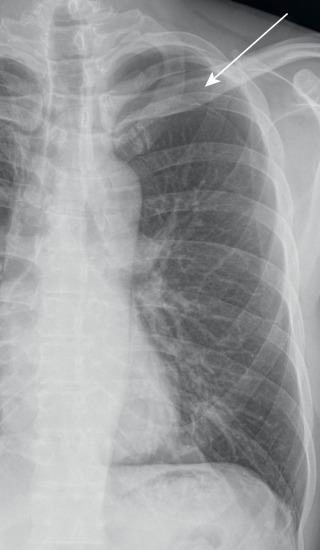
Potential pitfalls in the diagnosis of pneumothorax on CXR include misinterpretation of skin folds ( Fig. 7.13 ), overlying clothing, tubes and lines, an arching cortex of a rib, the bony contour of the superomedial scapula, the transverse process of an upper thoracic vertebral body, and cavitary and cystic lung disease as a pneumothorax. With further scrutiny, a skin fold can be discerned from a pneumothorax because it becomes increasingly opaque up to its margin, with abrupt lucency along its outer border (it forms an edge, not a line). In contrast, the lung subjacent to a pneumothorax typically remains lucent against the visceral pleural line unless it is opacified by atelectasis or acute or chronic parenchymal disease. CT is much more sensitive and specific in the detection of pneumothorax than CXR. Unsuspected small pneumothoraces can be seen at the anteromedial and basal aspects of the thorax in a supine patient. Ultrasonography may also be used at the bedside in emergency and intensive care unit settings to detect a pneumothorax, but less reliably than CT. There is risk of missing a pneumothorax on MRI because the signal void of interpleural air is not that different from healthy, aerated, or nondiseased lung, particularly on pulse sequences that do not show the pulmonary vasculature. As with plain radiography, on MRI, one must look for absence of vascularity within the pneumothorax compared with the adjacent lung. Because MRI is more sensitive than CT in the detection of endometrial implants, MRI should be considered when a woman presents with chest pain during menses or when a catamenial pneumothorax is contemplated on CXR or CT. The most sensitive and specific MRI pulse sequence for the detection of endometrial implants is a non–contrast-enhanced ultrafast three-dimensional gradient echo fat-saturated T1-weighted sequence.
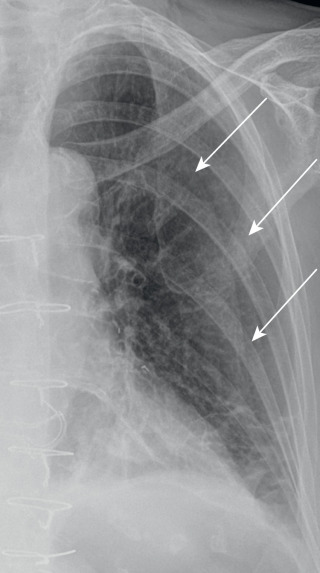
A tension pneumothorax develops when the pleural pressure exceeds the alveolar pressure. It is often caused by a flap-like or ball-valve mechanism of the pleural defect, from which air that enters the pleural space cannot exit, resulting in a progressively expanded pleural space, with the ultimate potential for cardiovascular collapse because of impaired venous return and diminished cardiac output. Tension pneumothorax is a clinical diagnosis and medical emergency. On CXR, it classically manifests as collapse of the ipsilateral lung, contralateral shift of the mediastinum, ipsilateral hemidiaphragmatic depression, and widened and expanded ipsilateral intercostal spaces or lesser findings along this spectrum ( Fig. 7.14 ).
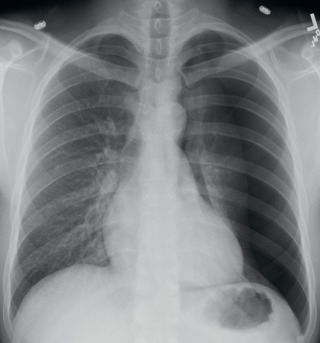
When a pneumothorax arises upon drainage of pleural fluid in the setting of chronic pulmonary parenchymal disease, a malignant pleural effusion, or long-standing hepatic hydrothorax, for example, it may simply reflect the inability of the lung to reexpand fully rather than the presence of an air leak. In this circumstance, the pneumothorax is termed pneumothorax ex vacuo and may not warrant a chest tube ( Fig. 7.15 ). A pneumothorax ex vacuo may resolve slowly or persist and has been associated with a poor prognosis.
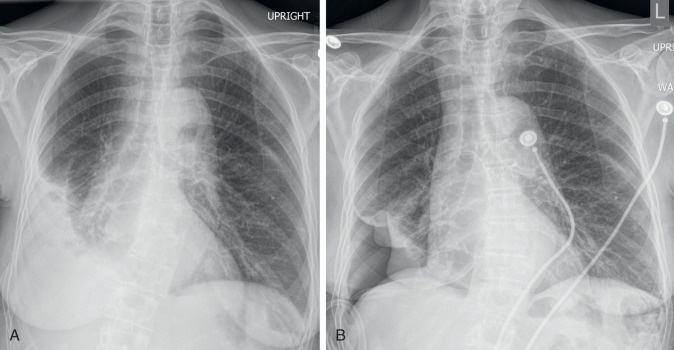
Pneumonectomy is defined as complete surgical removal of a lung. For pneumonectomy space dynamics, see Chapter 12 .
It can be difficult to detect recurrent tumor amidst the chronic pneumonectomy rind and fluid by CT. MRI, with its higher soft tissue contrast and, in particular, dynamic contrast-enhanced MRI, may be more sensitive and specific in this regard ( Fig. 7.16 ).
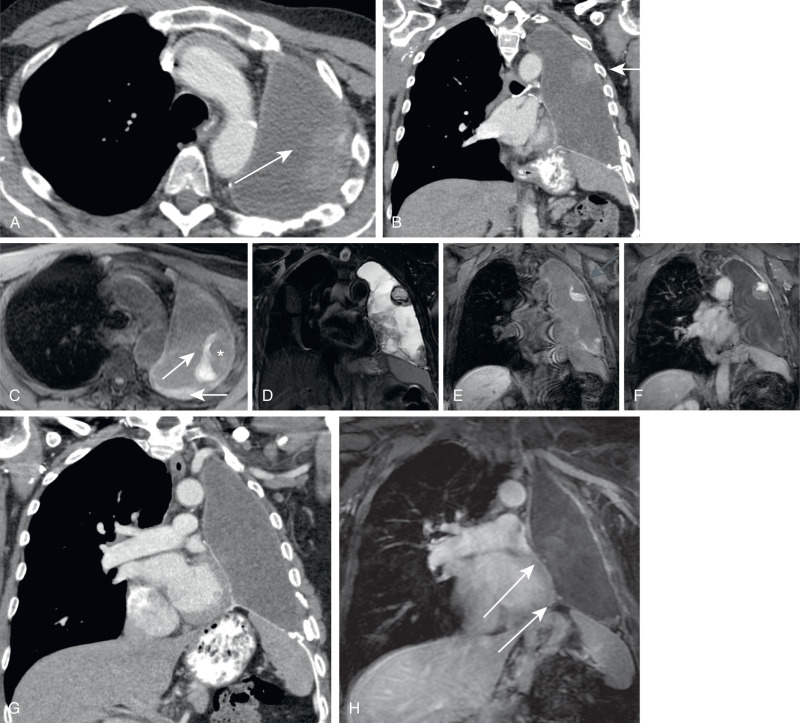
Asbestos-related pleural disease may be benign or malignant and consists of pleural effusions, pleural thickening, pleural plaques, and mesothelioma. There is a latency period between asbestos exposure and radiographic manifestations. Asbestos-related pleural effusions may occur 10 to 20 years after exposure, can be asymptomatic, and typically resolve on their own. Pleural plaques are the most commonly recognized manifestation of prior asbestos exposure. They, too, are often asymptomatic and are incidentally discovered on imaging unless they are severe enough to cause a fibrothorax. They typically manifest as bilateral, multifocal, primarily parietal pleural thickening and may be calcified and/or noncalcified. On CXR and in tangent, pleural plaques display themselves as localized bandlike or nodular areas of pleural thickening. En face, pleural plaques may appear as irregular geometric opacities, sometimes giving rise to a “holly leaf appearance.” Asbestos-related pleural plaques and pleural thickening relatively spare the lung apices, in contrast with pleural thickening by mesothelioma. Both may involve fissures. The presence of diaphragmatic pleural plaque is nearly pathognomonic for asbestos exposure. CT is more sensitive and specific than CXR in detecting pleural plaques ( Fig. 7.17 ).
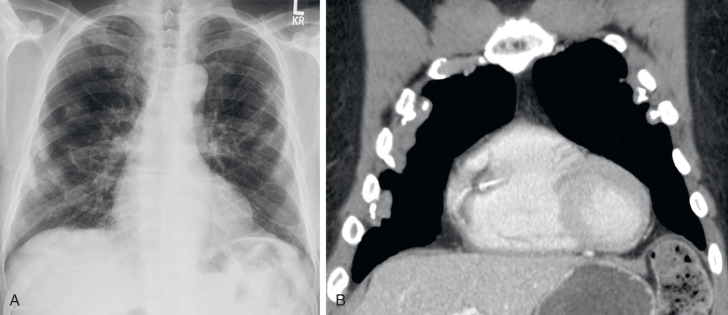
Non–asbestos-related pleural calcification and thickening may be caused by repeated pulmonary infection, prior empyema, prior surgery, radiation, or trauma, prior hemothorax, certain drugs such as methysergide, and rheumatoid arthritis. These non–asbestos-related forms of pleural thickening are more often unilateral and less multifocal.
A fibrothorax is defined as diffuse fibrosis and thickening of the pleura, with common causes including asbestos exposure, prior infection, empyema (classically from TB), chronic pleural inflammation (in the setting of rheumatoid arthritis or lupus), and hemothorax. When diffuse and extensive, it can limit the expansion of the lung, yielding a “trapped lung,” and compromised respiration. Surgical decortication can be performed, if clinically warranted, to treat this entity. CT and MRI help differentiate benign diffuse pleural thickening from neoplastic pleural involvement. Benign fibrothorax rarely involves the mediastinal pleura and is seldom nodular and mass-like, unlike mesothelioma and pleural metastases. Follow-up imaging by CT or MRI can help distinguish between these entities if initial findings are indeterminate.
Thoracoliths are rare, calcified or noncalcified “rolling stones” within the pleural space that do not typically cause symptoms ( Fig. 7.18 ).
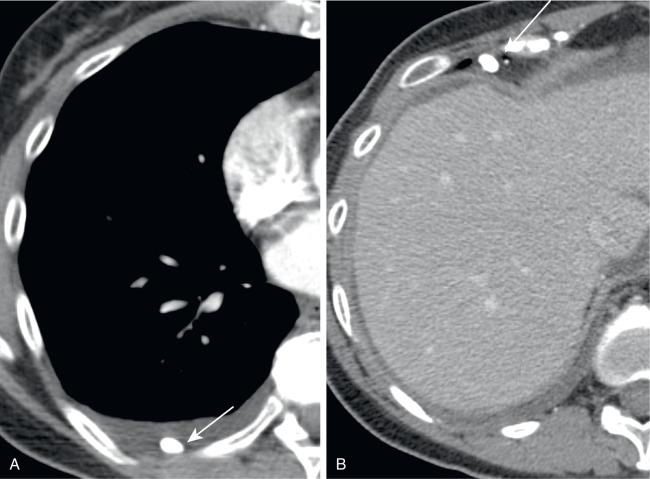
Solitary fibrous tumors (SFTs) are rare mesenchymal neoplasms that most commonly arise from the pleura, although they may also occur in the mediastinum and elsewhere in the body. They account for less than 5% of all pleural tumors and are not associated with asbestos exposure. These tumors are slow growing. Patients can be asymptomatic or may present with local or systemic effects produced by the tumor. Hypertrophic osteoarthropathy has been reported, along with clubbing and episodic hypoglycemia. Histologically, the majority of SFTs arise from the visceral pleura. Most of these tumors are low-grade neoplasms of variable cellularity and collagen content. Myxoid change and collagen degeneration may occur. Approximately 20% to 30% of SFTs are malignant, based on histologic criteria including high cellularity, high mitotic activity, and pleomorphism. Nevertheless, even benign SFTs may behave in a malignant manner and recur years later; hence, benign histopathology at surgical resection is of limited reassurance.
On CXR, SFTs often manifest as well-circumscribed, rounded and/or mildly lobulated pleural masses, with or without pedunculation. When on a pedicle, they may shift in location between studies. These tumors may exhibit faded margins when viewed en face, referred to as an “incomplete border sign” typical of pleural and extrapleural lesions, in which the portion of the mass surrounded by air in the lung exhibits a sharp border and the portion contiguous with the pleura does not. On CT, most of these tumors are well-circumscribed and, when large, can form acute angles with the pleural surface. They may enhance heterogeneously on account of internal hemorrhage or cystic degeneration, particularly the larger, more malignant tumors. Calcifications may be present in up to 25% of cases.
On MRI, solitary fibrous tumors of the pleura (SFTPs) are often heterogeneous in signal; however, they often contain areas of very low T2 signal intensity when sufficiently fibrous, on account of the tightly bundled collagen ( Fig. 7.19 ). When this low T2 signal is multifocal, the overall appearance has been referred to as the “chocolate chip cookie sign.” These tumors have been observed to enhance gradually and strongly over several minutes on dynamic contrast-enhanced imaging. Malignant SFTs tend to be larger (>10 cm in diameter), more heterogeneous in CT attenuation and MR signal, and more T2-hyperintense ( Fig. 7.20 ). These tumors may demonstrate aggressive features, including chest wall invasion. A small pleural effusion may accompany SFTPs. Hypertrophic osteoarthropathy, a periosteal reaction involving the diaphysis and metadiaphysis of the long bones of distal extremities, can occur not only in the setting of SFTP, but also in association with cardiovascular, hepatic, and gastrointestinal disorders. Clubbing of the fingers may be seen. When associated with a pulmonary condition, such as lung cancer, pulmonary metastatic disease, lung abscess, SFTP, and mesothelioma, it is termed hypertrophic pulmonary osteoarthropathy (HPOA).
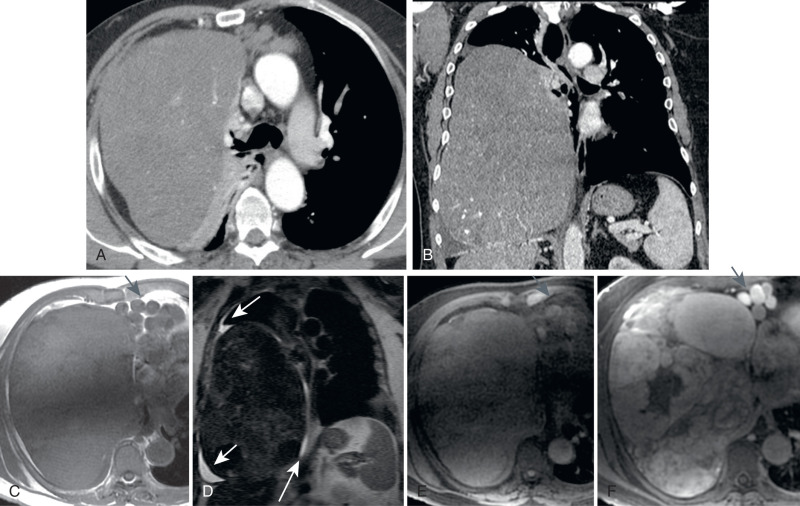
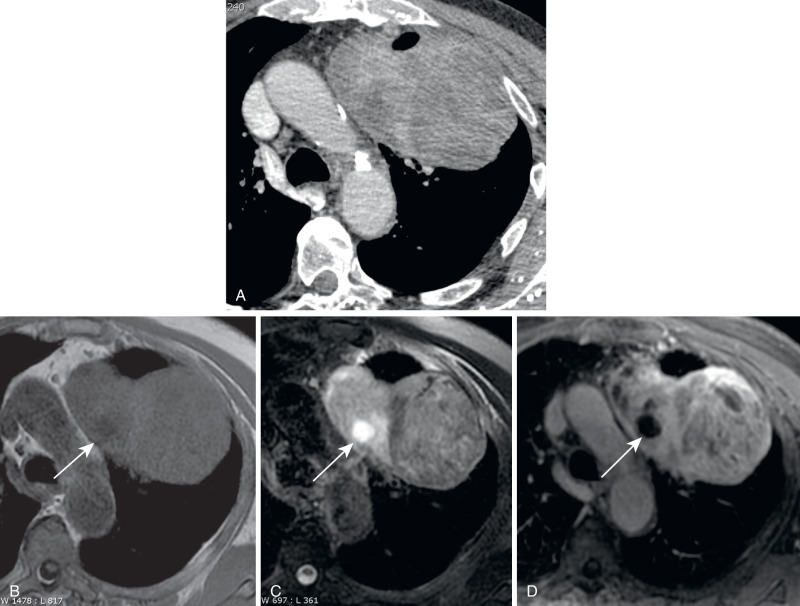
Become a Clinical Tree membership for Full access and enjoy Unlimited articles
If you are a member. Log in here